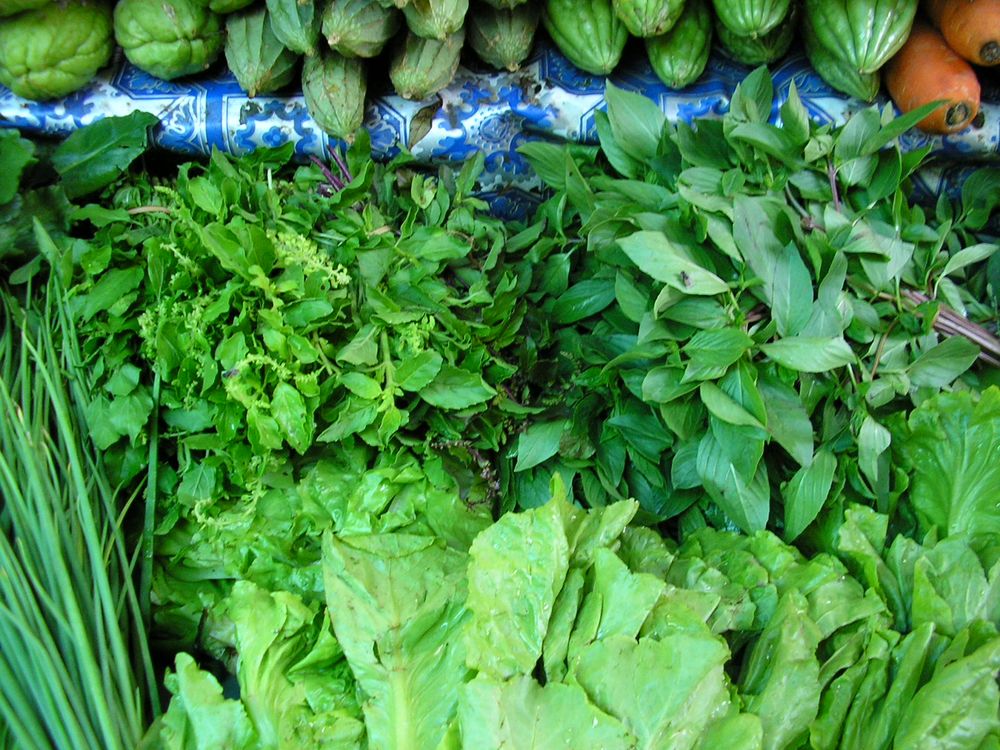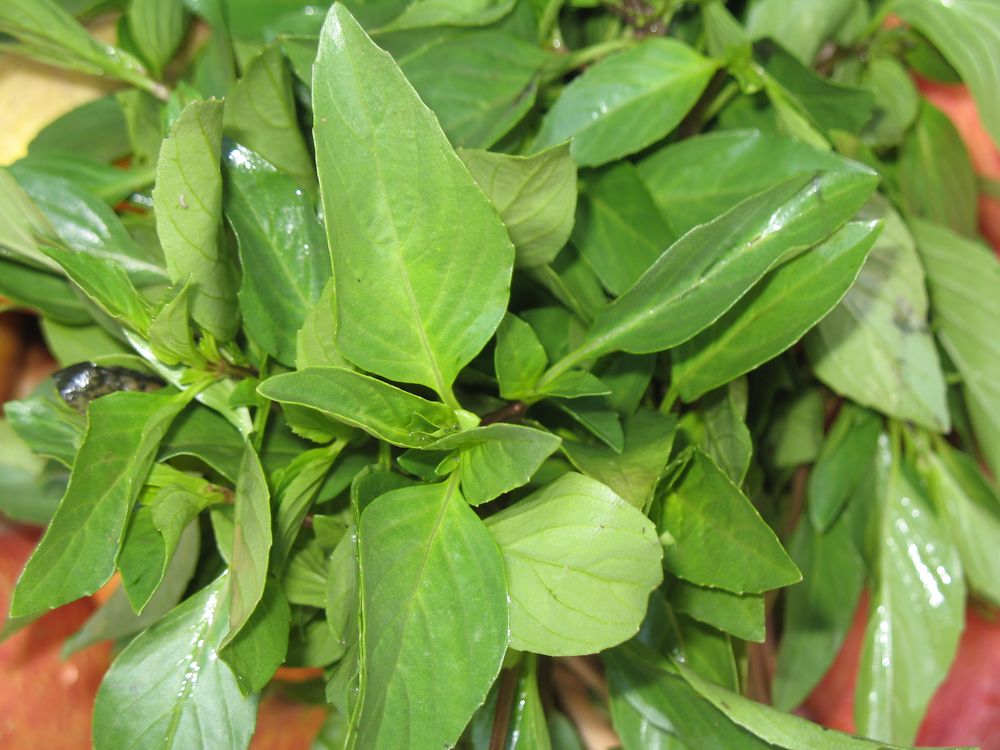Basils are aromatic plants native to Asia but cultivated all over the world and in almost all climates, as condiments, as medicines and as offerings. The species and varieties are very numerous and difficult to distinguish. In Laos, we can consider that there are three species of Ocimum (Lamiaceae family) mainly used: O. basilicum, O. gratissimum, O. sanctum.
Boualapha (Ocimum gratissimum) is the basil we know in Europe. It is higher, more woody than the previous one, its leaves are also larger and rougher and its smell less pronounced. Cooks put it in soups and in o lam; but there are regional variations in the uses of aromatics and for this stew the tendency would be to use in the North rather phak sy (Anethum graveolens), in the South rather boualapha, and in Vientiane rather phak kanièng (Limnophila geoffrayi). The recommended uses in traditional medicine are about the same as for Ocimum basilicum.
Les basilics sont des plantes aromatiques originaires d’Asie mais cultivées dans le monde entier et sous presque tous les climats, comme condiments, comme médicaments et comme offrandes. Les espèces et les variétés sont très nombreuses et difficiles à distinguer. Au Laos on peut considérer qu’il y a trois espèces d’Ocimum (famille des Lamiaceae) principalement utilisées: O. basilicum, O. gratissimum, O. sanctum.
Boualapha (Ocimum gratissimum) est le basilic que l’on connaît en Europe. Il est plus haut, plus ligneux que le précédent, ses feuilles sont aussi plus grandes et plus rêches et son odeur moins prononcée. Les cuisinières le mettent dans les soupes et dans le o lam; mais il y a des variations régionales dans les utilisations des aromates et pour ce ragoût la tendance serait d’utiliser dans le Nord plutôt phak sy (Anethum graveolens), dans le Sud plutôt boualapha, et à Vientiane plutôt phak kanièng (Limnophila geoffrayi). Les usages recommandés en médecine traditionnelle sont à peu près les mêmes que pour Ocimum basilicum.


Basils are aromatic plants native to Asia but cultivated all over the world and in almost all climates, as condiments, as medicines and as offerings. The species and varieties are very numerous and difficult to distinguish. In Laos, we can consider that there are three species of Ocimum (Lamiaceae family) mainly used: O. basilicum, O. gratissimum, O. sanctum.
Boualapha (Ocimum gratissimum) is the basil we know in Europe. It is higher, more woody than the previous one, its leaves are also larger and rougher and its smell less pronounced. Cooks put it in soups and in o lam; but there are regional variations in the uses of aromatics and for this stew the tendency would be to use in the North rather phak sy (Anethum graveolens), in the South rather boualapha, and in Vientiane rather phak kanièng (Limnophila geoffrayi). The recommended uses in traditional medicine are about the same as for Ocimum basilicum.
Les basilics sont des plantes aromatiques originaires d’Asie mais cultivées dans le monde entier et sous presque tous les climats, comme condiments, comme médicaments et comme offrandes. Les espèces et les variétés sont très nombreuses et difficiles à distinguer. Au Laos on peut considérer qu’il y a trois espèces d’Ocimum (famille des Lamiaceae) principalement utilisées: O. basilicum, O. gratissimum, O. sanctum.
Boualapha (Ocimum gratissimum) est le basilic que l’on connaît en Europe. Il est plus haut, plus ligneux que le précédent, ses feuilles sont aussi plus grandes et plus rêches et son odeur moins prononcée. Les cuisinières le mettent dans les soupes et dans le o lam; mais il y a des variations régionales dans les utilisations des aromates et pour ce ragoût la tendance serait d’utiliser dans le Nord plutôt phak sy (Anethum graveolens), dans le Sud plutôt boualapha, et à Vientiane plutôt phak kanièng (Limnophila geoffrayi). Les usages recommandés en médecine traditionnelle sont à peu près les mêmes que pour Ocimum basilicum.




Basils are aromatic plants native to Asia but cultivated all over the world and in almost all climates, as condiments, as medicines and as offerings. The species and varieties are very numerous and difficult to distinguish. In Laos, we can consider that there are three species of Ocimum (Lamiaceae family) mainly used: O. basilicum, O. gratissimum, O. sanctum.
Boualapha (Ocimum gratissimum) is the basil we know in Europe. It is higher, more woody than the previous one, its leaves are also larger and rougher and its smell less pronounced. Cooks put it in soups and in o lam; but there are regional variations in the uses of aromatics and for this stew the tendency would be to use in the North rather phak sy (Anethum graveolens), in the South rather boualapha, and in Vientiane rather phak kanièng (Limnophila geoffrayi). The recommended uses in traditional medicine are about the same as for Ocimum basilicum.
Les basilics sont des plantes aromatiques originaires d’Asie mais cultivées dans le monde entier et sous presque tous les climats, comme condiments, comme médicaments et comme offrandes. Les espèces et les variétés sont très nombreuses et difficiles à distinguer. Au Laos on peut considérer qu’il y a trois espèces d’Ocimum (famille des Lamiaceae) principalement utilisées: O. basilicum, O. gratissimum, O. sanctum.
Boualapha (Ocimum gratissimum) est le basilic que l’on connaît en Europe. Il est plus haut, plus ligneux que le précédent, ses feuilles sont aussi plus grandes et plus rêches et son odeur moins prononcée. Les cuisinières le mettent dans les soupes et dans le o lam; mais il y a des variations régionales dans les utilisations des aromates et pour ce ragoût la tendance serait d’utiliser dans le Nord plutôt phak sy (Anethum graveolens), dans le Sud plutôt boualapha, et à Vientiane plutôt phak kanièng (Limnophila geoffrayi). Les usages recommandés en médecine traditionnelle sont à peu près les mêmes que pour Ocimum basilicum.


